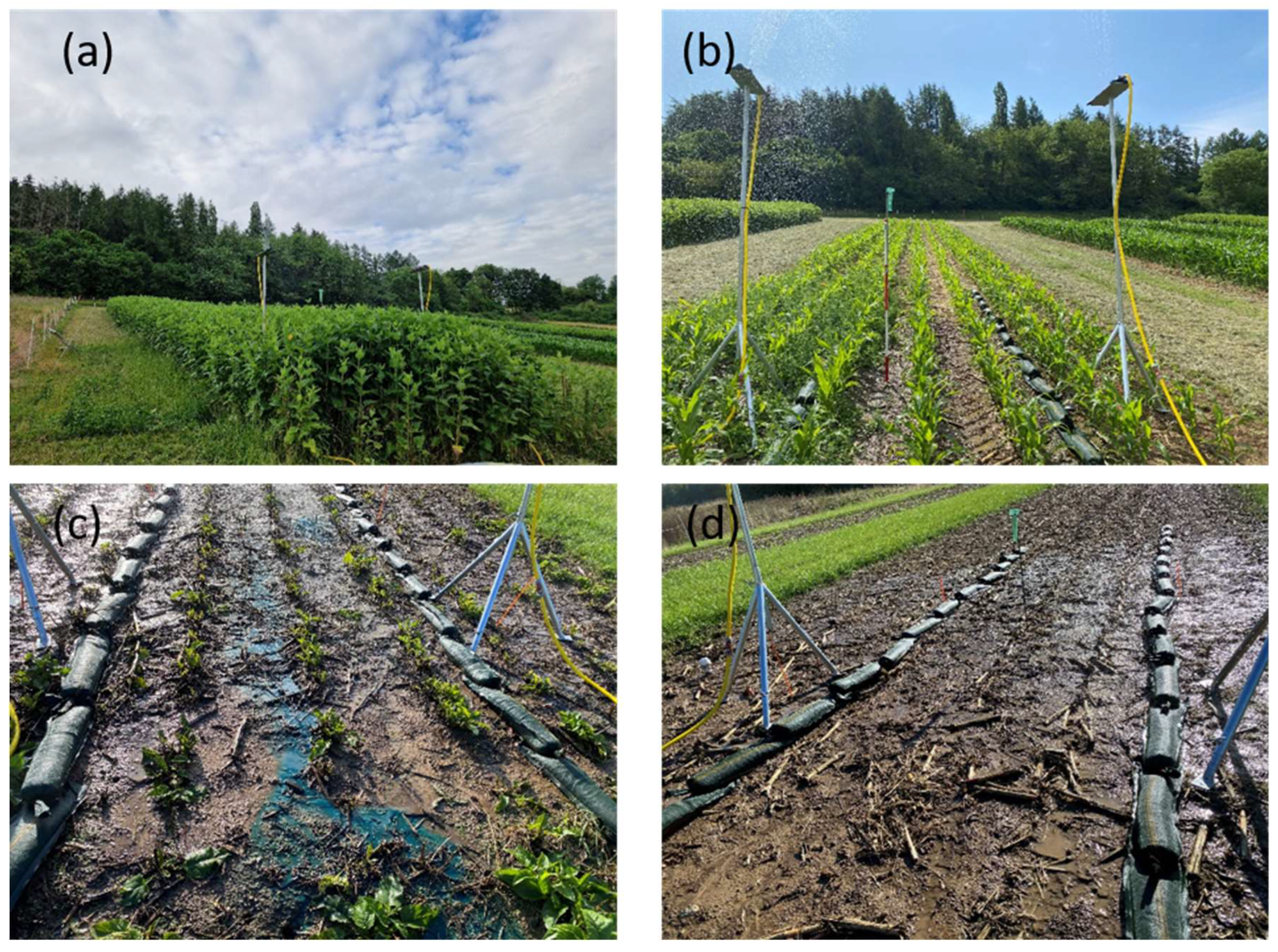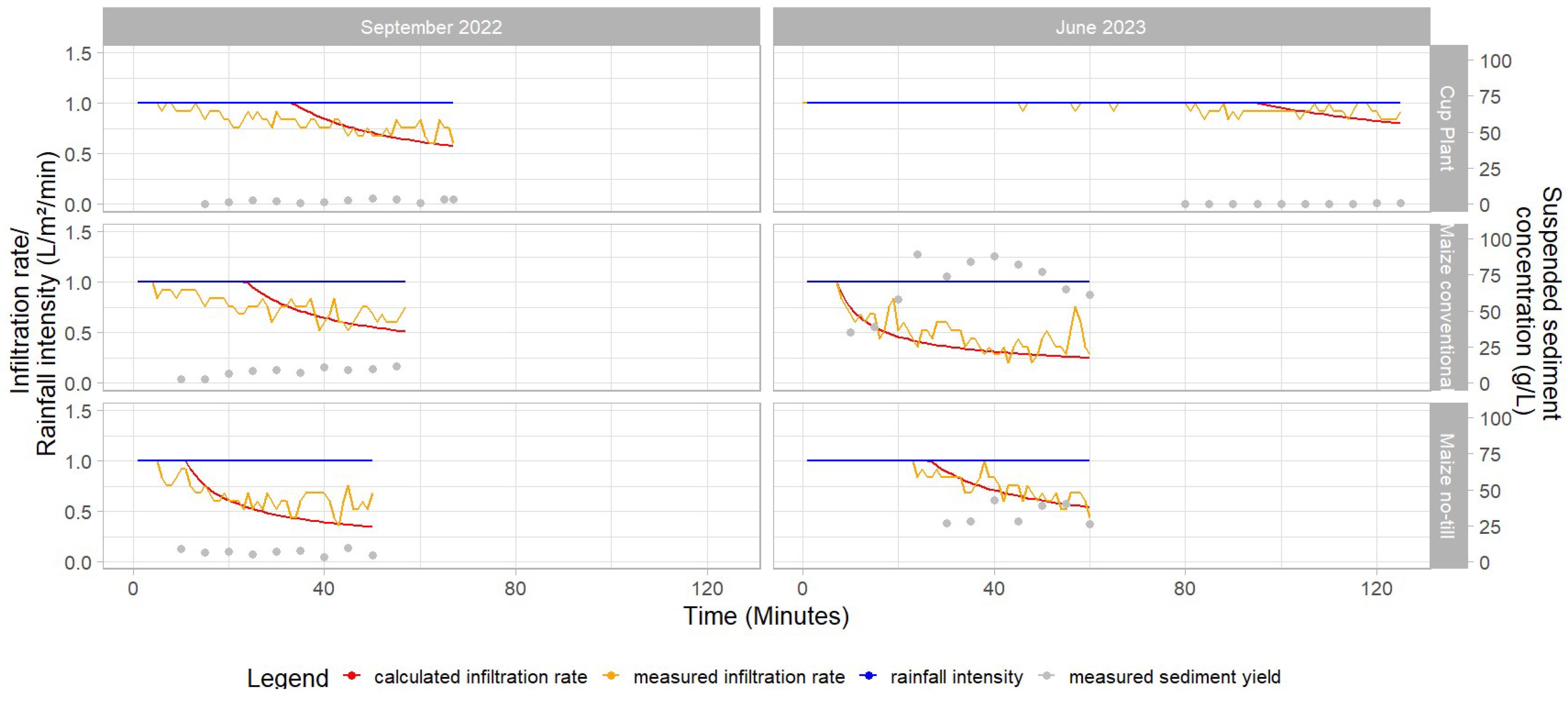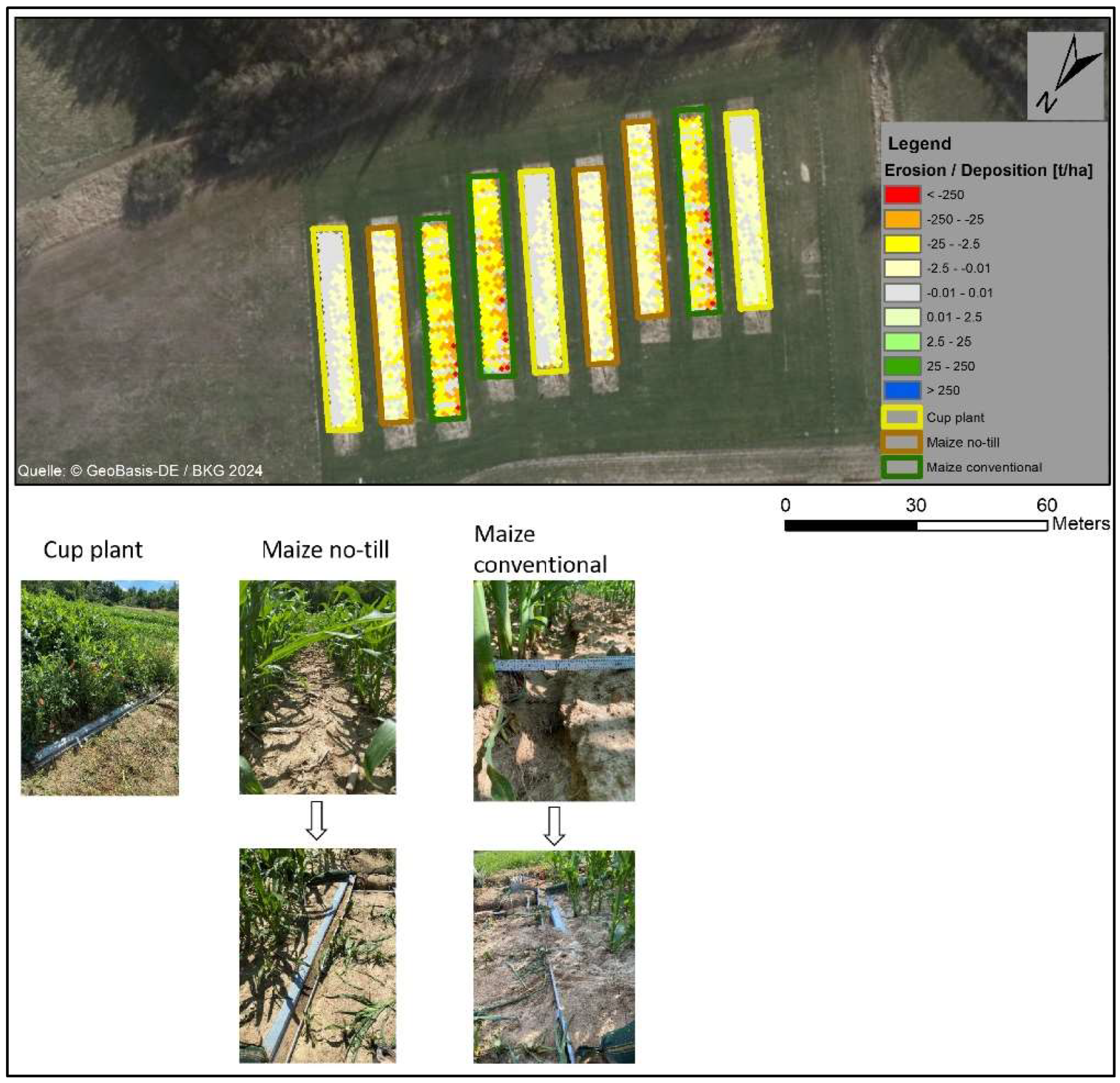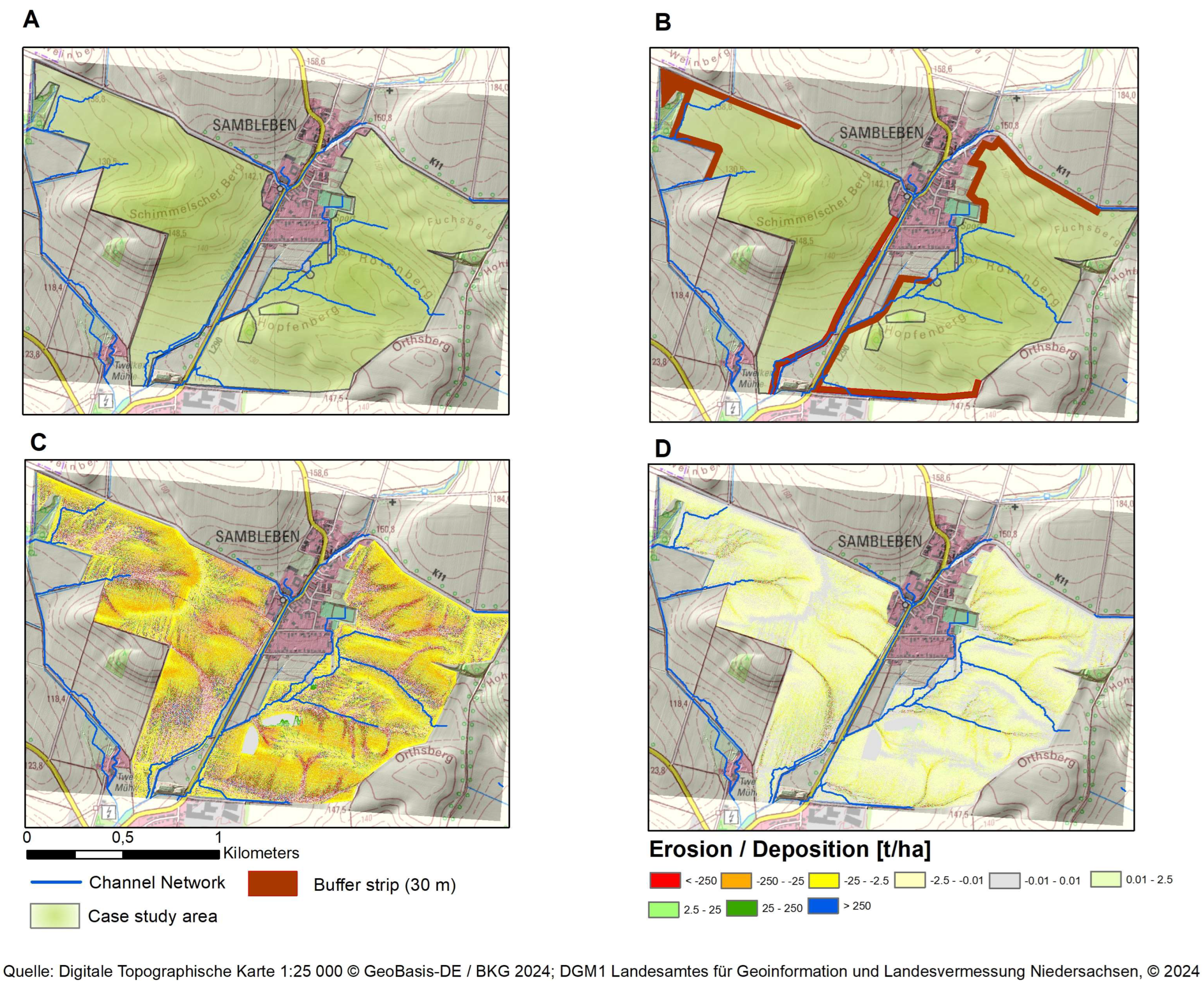From Field to Model: Determining EROSION 3D Model Parameters for the Emerging Biomass Plant Silphium perfoliatum L. to Predict Effects on Water Erosion Processes
Abstract
:1. Introduction
2. Materials and Methods
2.1. Site Characteristics and Site Management
2.2. Rainfall Simulator Experiment for Model Calibration
- an automated sprinkler to generate and distribute water droplets;
- a tripod to elevate the sprinkler with an adjustable height of up to 3 m;
- a pump to supply the system with water from a tank;
- a water tank supplying the system with water.
2.3. Natural Runoff and Soil Erosion Measurement
2.4. Model Background
2.5. Determining Input Parameters from Experimental Data
2.6. Validation of the Model Performance
2.7. Model Simulation to Explore Management Effects on Soil Erosion Using Experimentally Determined Parameters
- The first “worst case” scenario represents conventional maize cultivation across the entire field. This scenario serves as a baseline for comparison, reflecting typical farming practices for bioenergy cropping.
- In the second scenario, maize would be cultivated without tillage (no-till).
- In a third scenario, established cup plant stands would grow on the test sites.
- The fourth scenario combines conventional maize cultivation with a buffer strip (30 m width) cultivated with cup plant for water retention and soil protection.
- Lastly, the fifth scenario combines no-till maize with the same buffer strip.
3. Results
3.1. Rainfall Simulation for Model Calibration
3.2. Natural Precipitation Events for Model Validation
3.3. Case Study on the Application of Cup Plant Parameters to Model Cultivation Strategies and Their Impact on Soil Erosion
4. Discussion
4.1. Rainfall Simulation for Skinfactor Calibration
4.2. Validation of Skinfactor Values
4.3. Case Study
5. Conclusions
Author Contributions
Funding
Data Availability Statement
Acknowledgments
Conflicts of Interest
References
- Montanarella, L.; Panagos, P. The relevance of sustainable soil management within the European Green Deal. Land Use Policy 2021, 100, 104950. [Google Scholar] [CrossRef]
- Di Stefano, C.; Nicosia, A.; Pampalone, V.; Ferro, V. Soil loss tolerance in the context of the European Green Deal. Heliyon 2023, 9, e12869. [Google Scholar] [CrossRef] [PubMed]
- FAO. Voluntary Guidlines for Sustainable Soil Management; FAO: Rome, Italy, 2017; Available online: https://openknowledge.fao.org/server/api/core/bitstreams/9a5b9373-3558-43b3-b732-f69326a7314d/content (accessed on 2 September 2024).
- Sims, R.E.H.; Hastings, A.; Schlamadinger, B.; Taylor, G.; Smith, P. Energy crops: Current status and future prospects. Glob. Chang. Biol. 2006, 12, 2054–2076. [Google Scholar] [CrossRef]
- Bundesministerium für Justiz. Gesetz für den Ausbau Erneuerbarar Energien: EEG; Bundesministerium für Justiz: Berlin, Germany, 2023; Available online: https://www.gesetze-im-internet.de/eeg_2014/EEG_2023.pdf (accessed on 2 August 2024).
- FNR. Anbau und Verwendung Nachwachsender Rohstoffe in Deutschland. Fachagentur Nachwachsende Rohstoffe e. V.: Gülzow, Germany, 2022; Available online: https://www.fnr.de/ftp/pdf/berichte/22004416.pdf (accessed on 2 August 2024).
- Schoo, B.; Wittich, K.P.; Böttcher, U.; Kage, H.; Schittenhelm, S. Drought Tolerance and Water-Use Efficiency of Biogas Crops: A Comparison of Cup Plant, Maize and Lucerne-Grass. J. Agron. Crop Sci. 2017, 203, 117–130. [Google Scholar] [CrossRef]
- Foley, J.A.; Ramankutty, N.; Brauman, K.A.; Cassidy, E.S.; Gerber, J.S.; Johnston, M.; Mueller, N.D.; O’Connell, C.; Ray, D.K.; West, P.C.; et al. Solutions for a cultivated planet. Nature 2011, 478, 337–342. [Google Scholar] [CrossRef] [PubMed]
- Vogel, E.; Deumlich, D.; Kaupenjohann, M. Bioenergy maize and soil erosion—Risk assessment and erosion control concepts. Geoderma 2016, 261, 80–92. [Google Scholar] [CrossRef]
- Boardman, J.; Vandaele, K. Soil erosion and runoff: The need to rethink mitigation strategies for sustainable agricultural landscapes in western Europe. Soil Use Manag. 2023, 39, 673–685. [Google Scholar] [CrossRef]
- Ruf, T.; Gilcher, M.; Udelhoven, T.; Emmerling, C. Implications of Bioenergy Cropping for Soil: Remote Sensing Identification of Silage Maize Cultivation and Risk Assessment Concerning Soil Erosion and Compaction. Land 2021, 10, 128. [Google Scholar] [CrossRef]
- Deumlich, D. Erosive Niederschläge und ihre Eintrittswahrscheinlichkeit im Nordosten Deutschlands. Meteorol. Z. 1999, 8, 155–161. [Google Scholar] [CrossRef]
- Gericke, A.; Kiesel, J.; Deumlich, D.; Venohr, M. Recent and Future Changes in Rainfall Erosivity and Implications for the Soil Erosion Risk in Brandenburg, NE Germany. Water 2019, 11, 904. [Google Scholar] [CrossRef]
- Panagos, P.; Borrelli, P.; Matthews, F.; Liakos, L.; Bezak, N.; Diodato, N.; Ballabio, C. Global rainfall erosivity projections for 2050 and 2070. J. Hydrol. 2022, 610, 127865. [Google Scholar] [CrossRef]
- Auerswald, K.; Menzel, A. Change in erosion potential of crops due to climate change. Agric. For. Meteorol. 2021, 300, 108338. [Google Scholar] [CrossRef]
- Pimentel, D. Soil Erosion: A Food and Environmental Threat. Environ. Dev. Sustain 2006, 8, 119–137. [Google Scholar] [CrossRef]
- Panagos, P.; Imeson, A.; Meusburger, K.; Borrelli, P.; Poesen, J.; Alewell, C. Soil Conservation in Europe: Wish or Reality? Land Degrad. Dev. 2016, 27, 1547–1551. [Google Scholar] [CrossRef]
- Evans, D.L.; Quinton, J.N.; Davies, J.A.C.; Zhao, J.; Govers, G. Soil lifespans and how they can be extended by land use and management change. Environ. Res. Lett. 2020, 15, 0940b2. [Google Scholar] [CrossRef]
- Patault, E.; Ledun, J.; Landemaine, V.; Soulignac, A.; Richet, J.-B.; Fournier, M.; Ouvry, J.-F.; Cerdan, O.; Laignel, B. Analysis of off-site economic costs induced by runoff and soil erosion: Example of two areas in the northwestern European loess belt for the last two decades (Normandy, France). Land Use Policy 2021, 108, 105541. [Google Scholar] [CrossRef]
- Panagos, P.; Matthews, F.; Patault, E.; de Michele, C.; Quaranta, E.; Bezak, N.; Kaffas, K.; Patro, E.R.; Auel, C.; Schleiss, A.J.; et al. Understanding the cost of soil erosion: An assessment of the sediment removal costs from the reservoirs of the European Union. J. Clean. Prod. 2024, 434, 140183. [Google Scholar] [CrossRef]
- Lal, R. Soil Erosion and Gaseous Emissions. Appl. Sci. 2020, 10, 2784. [Google Scholar] [CrossRef]
- Friedlingstein, P.; O’Sullivan, M.; Jones, M.W.; Andrew, R.M.; Bakker, D.C.E.; Hauck, J.; Landschützer, P.; Le Quéré, C.; Luijkx, I.T.; Peters, G.P.; et al. Global Carbon Budget 2023. Earth Syst. Sci. Data 2023, 15, 5301–5369. [Google Scholar] [CrossRef]
- Mattia, C.; Lovell, S.T.; Fraterrigo, J. Identifying marginal land for Multifunctional Perennial Cropping Systems in the Upper Sangamon River watershed, Illinois. J. Soil Water Conserv. 2018, 73, 669–681. [Google Scholar] [CrossRef]
- Næss, J.S.; Hu, X.; Gvein, M.H.; Iordan, C.-M.; Cavalett, O.; Dorber, M.; Giroux, B.; Cherubini, F. Climate change mitigation potentials of biofuels produced from perennial crops and natural regrowth on abandoned and degraded cropland in Nordic countries. J. Environ. Manag. 2023, 325, 116474. [Google Scholar] [CrossRef] [PubMed]
- Gyssels, G.; Poesen, J.; Bochet, E.; Li, Y. Impact of plant roots on the resistance of soils to erosion by water: A review. Prog. Phys. Geogr. Earth Environ. 2005, 29, 189–217. [Google Scholar] [CrossRef]
- Deng, L.; Liu, G.-B.; Shangguan, Z.-P. Land-use conversion and changing soil carbon stocks in China’s ‘Grain-for-Green’ Program: A synthesis. Glob. Chang. Biol. 2014, 20, 3544–3556. [Google Scholar] [CrossRef]
- Grunwald, D.; Panten, K.; Schwarz, A.; Bischoff, W.-A.; Schittenhelm, S. Comparison of maize, permanent cup plant and a perennial grass mixture with regard to soil and water protection. Glob. Chang. Biol. Bioenergy 2020, 12, 694–705. [Google Scholar] [CrossRef]
- Wang, E.; Cruse, R.M.; Sharma-Acharya, B.; Herzmann, D.E.; Gelder, B.K.; James, D.E.; Flanagan, D.C.; Blanco-Canqui, H.; Mitchell, R.B.; Laird, D.A. Strategic switchgrass (Panicum virgatum) production within row cropping systems: Regional-scale assessment of soil erosion loss and water runoff impacts. Glob. Chang. Biol. Bioenergy 2020, 12, 955–967. [Google Scholar] [CrossRef]
- Milazzo, F.; Francksen, R.M.; Zavattaro, L.; Abdalla, M.; Hejduk, S.; Enri, S.R.; Pittarello, M.; Price, P.N.; Schils, R.L.; Smith, P.; et al. The role of grassland for erosion and flood mitigation in Europe: A meta-analysis. Agric. Ecosyst. Environ. 2023, 348, 108443. [Google Scholar] [CrossRef]
- Gansberger, M.; Montgomery, L.F.; Liebhard, P. Botanical characteristics, crop management and potential of Silphium perfoliatum L. as a renewable resource for biogas production: A review. Ind. Crops Prod. 2015, 63, 362–372. [Google Scholar] [CrossRef]
- von Cossel, M. Renewable Energy from Wildflowers—Perennial Wild Plant Mixtures as a Social-Ecologically Sustainable Biomass Supply System. Adv. Sustain. Syst. 2020, 4, 2000037. [Google Scholar] [CrossRef]
- Häfner, B.; Dauber, J.; Schittenhelm, S.; Böning, L.M.; Darnauer, M.; Wenkebach, L.L.; Nürnberger, F. The perennial biogas crops cup plant (Silphium perfoliatum L.) and field grass pose better autumn and overwintering habitats for arthropods than silage maize (Zea mays L.). Glob. Chang. Biol. Bioenergy 2023, 15, 346–364. [Google Scholar] [CrossRef]
- Kemmann, B.; Ruf, T.; Well, R.; Emmerling, C.; Fuß, R. Greenhouse gas emissions from Silphium perfoliatum and silage maize cropping on Stagnosols. J. Plant Nutr. Soil Sci. 2022, 186, 79–94. [Google Scholar] [CrossRef]
- Ruf, T.; Emmerling, C. The effects of periodically stagnant soil water conditions on biomass and methane yields of Silphium perfoliatum. Biomass Bioenergy 2022, 160, 106438. [Google Scholar] [CrossRef]
- Burmeister, J.; Panassiti, B.; Heine, F.; Wolfrum, S.; Moriniere, J. Perennial alternative crops for biogas production increase arthropod abundance and diversity after harvest—Results of suction sampling and metabarcoding. Eur. J. Entomol. 2023, 120, 59–69. [Google Scholar] [CrossRef]
- Wöhl, L.; Ruf, T.; Emmerling, C.; Thiele, J.; Schrader, S. Assessment of Earthworm Services on Litter Mineralisation and Nutrient Release in Annual and Perennial Energy Crops (Zea mays vs. Silphium perfoliatum). Agriculture 2023, 13, 494. [Google Scholar] [CrossRef]
- Wöhl, L.; Ruf, T.; Emmerling, C.; Schrader, S. Earthworm communities and their relation to above-ground organic residues and water infiltration in perennial cup plant (Silphium perfoliatum) and annual silage maize (Zea mays) energy plants. Soil Use Manag. 2024, 40, e13041. [Google Scholar] [CrossRef]
- Bezak, N.; Mikoš, M.; Borrelli, P.; Alewell, C.; Alvarez, P.; Anache, J.A.A.; Baartman, J.; Ballabio, C.; Biddoccu, M.; Cerdà, A.; et al. Soil erosion modelling: A bibliometric analysis. Environ. Res. 2021, 197, 111087. [Google Scholar] [CrossRef]
- Borrelli, P.; Alewell, C.; Alvarez, P.; Anache, J.A.A.; Baartman, J.; Ballabio, C.; Bezak, N.; Biddoccu, M.; Cerdà, A.; Chalise, D.; et al. Soil erosion modelling: A global review and statistical analysis. Sci. Total Environ. 2021, 780, 146494. [Google Scholar] [CrossRef]
- Höfler, S.; Ringler, G.; Gumpinger, C.; Reebs, F.; Schnell, J.; Hauer, C. Landscape Changes in the Bavarian Foothills since the 1960s and the Effects on Predicted Erosion Processes and Control. Water 2024, 16, 417. [Google Scholar] [CrossRef]
- Raza, A.; Ahrends, H.; Habib-Ur-Rahman, M.; Gaiser, T. Modeling Approaches to Assess Soil Erosion by Water at the Field Scale with Special Emphasis on Heterogeneity of Soils and Crops. Land 2021, 10, 422. [Google Scholar] [CrossRef]
- Schmidt, J.; von Werner, M.; Michael, A.; Schmidt, W. Erosion-2D/3D: Ein Computermodell zur Simulation der Bodenerosion durch Wasser; Sächsische Landesanstalt für Landwirtschaft: Dresden/Freiberg, Germany, 1996. [Google Scholar]
- Morgan, R.; Nearing, M.A. Handbook of Erosion Modelling; Wiley-Blackwell: Chichester, UK, 2011; ISBN 978-1-4051-9010-7. [Google Scholar]
- Environmental Modelling: Finding Simplicity in Complexity, 2nd ed.; Wainwright, J.; Mulligan, M. (Eds.) Wiley-Blackwell: Chicester, UK, 2013; ISBN 0470749113. [Google Scholar]
- Schindewolf, M.; Schmidt, W. Erosion 3D Sachsen: Flächendeckende Abbildung der Bodenerosion durch Wasser für Sachsen unter Anwendung des Modells Erosion 3D; Sächsisches Landesamt für Umwelt, Landwirtschaft und Geologie: Dresden, Germany, 2010; Available online: https://publikationen.sachsen.de/bdb/artikel/15139 (accessed on 7 August 2024).
- Koch, T.; Deumlich, D.; Chifflard, P.; Panten, K.; Grahmann, K. Using model simulation to evaluate soil loss potential in diversified agricultural landscapes. Eur. J Soil Sci. 2023, 74, e13332. [Google Scholar] [CrossRef]
- Lenz, J.; Yousuf, A.; Schindewolf, M.; von Werner, M.; Hartsch, K.; Singh, M.; Schmidt, J. Parameterization for EROSION-3D Model under Simulated Rainfall Conditions in Lower Shivaliks of India. Geosciences 2018, 8, 396. [Google Scholar] [CrossRef]
- Jetten, V.; de Roo, A.; Favis-Mortlock, D. Evaluation of field-scale and catchment-scale soil erosion models. CATENA 1999, 37, 521–541. [Google Scholar] [CrossRef]
- Hebel, B. Validierung Numerischer Erosionsmodelle in Einzelhang- und Einzugsgebiet-Dimension; Basler Beiträge zur Physiogeographie; Universität Basel: Basel, Switzerland, 2003. [Google Scholar]
- Németová, Z.; Honek, D.; Kohnová, S.; Hlavčová, K.; Šulc Michalková, M.; Sočuvka, V.; Velísková, Y. Validation of the EROSION-3D Model through Measured Bathymetric Sediments. Water 2020, 12, 1082. [Google Scholar] [CrossRef]
- Beitlerová, H.; Lenz, J.; Devátý, J.; Mistr, M.; Kapička, J.; Buchholz, A.; Gerndtová, I.; Routschek, A. Improved calibration of the Green–Ampt infiltration module in the EROSION-2D/3D model using a rainfall-runoff experiment database. SOIL 2021, 7, 241–253. [Google Scholar] [CrossRef]
- Michael, A. Anwendung des physikalisch Begründeten Erosionsprognosemodells EROSION 2D/3D—Empirische Ansätze zur Ableitung der Modellparameter. Ph.D. Dissertation, Technische Universität Bergakademie Freiberg, Freiberg, Germany, 2000. [Google Scholar]
- Schindewolf, M.; Schmidt, J. Parameterization of the EROSION 2D/3D soil erosion model using a small-scale rainfall simulator and upstream runoff simulation. CATENA 2012, 91, 47–55. [Google Scholar] [CrossRef]
- IUSS Working Group WRB. World Reference Base for Soil Resources 2014: International Soil Classification System for Naming Soils and Creating Legends for Soil Maps; FAO: Rome, Italy, 2014; ISBN 978-92-5-108369-7. [Google Scholar]
- DWD. Vieljähriges Mittel der Raster der Niederschlagshöhe für Deutschland 1991–2020; Deutscher Wetterdienst: Offenbach am Main, Germany, 2021. [Google Scholar]
- DIN 19708:2017-08; Bodenbeschaffenheit_—Ermittlung der Erosionsgefährdung von Böden durch Wasser mit Hilfe der ABAG. Beuth Verlag GmbH: Berlin, Germany, 2017.
- Riegler-Nurscher, P.; Prankl, J.; Bauer, T.; Strauss, P.; Prankl, H. A machine learning approach for pixel wise classification of residue and vegetation cover under field conditions. Biosyst. Eng. 2018, 169, 188–198. [Google Scholar] [CrossRef]
- Nielsen, K.T.; Moldrup, P.; Thorndahl, S.; Nielsen, J.E.; Duus, L.B.; Rasmussen, S.H.; Uggerby, M.; Rasmussen, M.R. Automated rainfall simulator for variable rainfall on urban green areas. Hydrol. Process. 2019, 33, 3364–3377. [Google Scholar] [CrossRef]
- Christiansen, J.E. Irrigation by Sprinkling; Bulletin No. 670; University of California: Berkeley, CA, USA, 1942. [Google Scholar]
- Koch, T.; Chifflard, P.; Aartsma, P.; Panten, K. A review of the characteristics of rainfall simulators in soil erosion research studies. MethodsX 2024, 12, 102506. [Google Scholar] [CrossRef]
- Iserloh, T.; Ries, J.B.; Arnáez, J.; Boix-Fayos, C.; Butzen, V.; Cerdà, A.; Echeverría, M.T.; Fernández-Gálvez, J.; Fister, W.; Geißler, C.; et al. European small portable rainfall simulators: A comparison of rainfall characteristics. CATENA 2013, 110, 100–112. [Google Scholar] [CrossRef]
- Stroosnijder, L. Measurement of erosion: Is it possible? CATENA 2005, 64, 162–173. [Google Scholar] [CrossRef]
- Gerlach, T. Hillslope troughs for measuring sediment movement. Rev. Geomorphol. Dyn. 1967, 17, 173. [Google Scholar]
- von Werner, M. GIS-orientierte Methoden der Digitalen Reliefanalyse zur Modellierung von Bodenerosion in kleinen Einzugsgebieten. Ph.D. Dissertation, Freie Universität, Berlin, Germany, 1995. [Google Scholar]
- Campbell, G.S. Soil Physics with BASIC: Transport Models for Soil-Plant Systems; Elsevier: Amsterdam, The Netherlands, 1985. [Google Scholar]
- Schmidt, J.; Werner, M.v.; Schindewolf, M. Wind effects on soil erosion by water—A sensitivity analysis using model simulations on catchment scale. CATENA 2017, 148, 168–175. [Google Scholar] [CrossRef]
- Lenz, J. Toolbox for the Soil Erosion Modeling Tool EROSION-3D. 2022. Available online: https://github.com/jonaslenz/toolbox.e3d (accessed on 8 August 2024).
- Wischmeier, W.H.; Smith, D.D. Predicting Rainfall Erosion Losses. A Guide to Conservation Planning; Agriculture Handbook 537; United States Department of Agriculture: Hyattsville, MD, USA, 1978.
- Auerswald, K.; Fischer, F.K.; Winterrath, T.; Brandhuber, R. Rain erosivity map for Germany derived from contiguous radar rain data. Hydrol. Earth Syst. Sci. 2019, 23, 1819–1832. [Google Scholar] [CrossRef]
- Deumlich, D.; Gericke, A. Frequency Trend Analysis of Heavy Rainfall Days for Germany. Water 2020, 12, 1950. [Google Scholar] [CrossRef]
- Emmerling, C. Impact of land-use change towards perennial energy crops on earthworm population. Appl. Soil Ecol. 2014, 84, 12–15. [Google Scholar] [CrossRef]
- Emmerling, C.; Schmidt, A.; Ruf, T.; von Francken-Welz, H.; Thielen, S. Impact of newly introduced perennial bioenergy crops on soil quality parameters at three different locations in W-Germany. J. Plant Nutr. Soil Sci. 2017, 180, 759–767. [Google Scholar] [CrossRef]
- Schorpp, Q.; Schrader, S. Earthworm functional groups respond to the perennial energy cropping system of the cup plant (Silphium perfoliatum L.). Biomass Bioenergy 2016, 87, 61–68. [Google Scholar] [CrossRef]
- Jarvis, N.; Koestel, J.; Messing, I.; Moeys, J.; Lindahl, A. Influence of soil, land use and climatic factors on the hydraulic conductivity of soil. Hydrol. Earth Syst. Sci. 2013, 17, 5185–5195. [Google Scholar] [CrossRef]
- Wardak, D.L.R.; Padia, F.N.; de Heer, M.I.; Sturrock, C.J.; Mooney, S.J. Zero-tillage induces significant changes to the soil pore network and hydraulic function after 7 years. Geoderma 2024, 447, 116934. [Google Scholar] [CrossRef]
- Schmidt, J.; Werner, M.; Michael, A. Application of the EROSION 3D model to the CATSOP watershed, The Netherlands. CATENA 1999, 37, 449–456. [Google Scholar] [CrossRef]
- Blanco-Canqui, H. Energy Crops and Their Implications on Soil and Environment. Agron. J. 2010, 102, 403–419. [Google Scholar] [CrossRef]
- Blouin, M.; Hodson, M.E.; Delgado, E.A.; Baker, G.; Brussaard, L.; Butt, K.R.; Dai, J.; Dendooven, L.; Peres, G.; Tondoh, J.E.; et al. A review of earthworm impact on soil function and ecosystem services. Eur. J. Soil Sci. 2013, 64, 161–182. [Google Scholar] [CrossRef]
- Fischer, C.; Roscher, C.; Jensen, B.; Eisenhauer, N.; Baade, J.; Attinger, S.; Scheu, S.; Weisser, W.W.; Schumacher, J.; Hildebrandt, A. How do earthworms, soil texture and plant composition affect infiltration along an experimental plant diversity gradient in grassland? PLoS ONE 2014, 9, e98987. [Google Scholar] [CrossRef]
- Deumlich, D.; JHA, A.; Kirchner, G. Comparing measurements, 7Be radiotracer technique and process-based erosion model for estimating short-term soil loss from cultivated land in Northern Germany. Soil Water Res. 2017, 12, 177–186. [Google Scholar] [CrossRef]
- Hinsberger, R. Analysis of heavy precipitation-induced rill erosion. Environ. Earth Sci. 2024, 83, 354. [Google Scholar] [CrossRef]
- Kinnell, P. A review of the design and operation of runoff and soil loss plots. CATENA 2016, 145, 257–265. [Google Scholar] [CrossRef]
- Fiener, P.; Wilken, F.; Auerswald, K. Filling the gap between plot and landscape scale—Eight years of soil erosion monitoring in 14 adjacent watersheds under soil conservation at Scheyern, Southern Germany. Adv. Geosci. 2019, 48, 31–48. [Google Scholar] [CrossRef]
- Ellerbrock, R.H.; Niessner, D.; Deumlich, D.; Puppe, D.; Gerke, H.H. Infrared-based analysis of organic matter composition in liquid and solid runoff fractions collected during a single erosion event. Soil Tillage Res. 2024, 235, 105901. [Google Scholar] [CrossRef]
- Wendt, R.C.; Alberts, E.E.; Hjelmfelt, A.T. Variability of Runoff and Soil Loss from Fallow Experimental Plots. Soil Sci. Soc. Am. J. 1986, 50, 730–736. [Google Scholar] [CrossRef]
- Kreig, J.A.; Ssegane, H.; Chaubey, I.; Negri, M.C.; Jager, H.I. Designing bioenergy landscapes to protect water quality. Biomass Bioenergy 2019, 128, 105327. [Google Scholar] [CrossRef]
- Sahu, M.; Gu, R.R. Modeling the effects of riparian buffer zone and contour strips on stream water quality. Ecol. Eng. 2009, 35, 1167–1177. [Google Scholar] [CrossRef]
- Liu, X.; Zhang, X.; Zhang, M. Major factors influencing the efficacy of vegetated buffers on sediment trapping: A review and analysis. J. Environ. Qual. 2008, 37, 1667–1674. [Google Scholar] [CrossRef]
- Efroymson, R.A.; Langholtz, M.H. 2016 Billion-Ton Report: Advancing Domestic Resources for a Thriving Bioeconomy, Volume 2: Environmental Sustainability Effects of Select Scenarios from Volume 1; U.S. Department of Energy: Oak Ridge, TN, USA, 2017. [Google Scholar] [CrossRef]
- Deumlich, D.; Völker, L.; Funk, R.; Koch, T. The Slope Association Type as a Comparative Index for the Evaluation of Environmental Risks. Water 2021, 13, 3333. [Google Scholar] [CrossRef]





| Input Parameter | Unit | Data Source |
|---|---|---|
| Altitude DEM | (m) | Digital elevation model with a resolution of 1 m (Landesamt für Geoinformation und Landesvermessung Niedersachsen LGLN © 2024) |
| Soil cover | % | Field measurement |
| Bulk density | kg/m3 | Field measurement according to DIN ISO 11272 (available online: https://www.dinmedia.de/de/norm/din-en-iso-11272/263368180 (accessed 2 September 2024)) |
| Soil organic carbon content | % | Field measurement according to DIN ISO 10694 (available online: https://www.dinmedia.de/de/norm/din-iso-10694/2799936 (accessed 2 September 2024)) |
| Grain size distribution | % | Field measurement according to DIN ISO 11277 (available online: https://www.dinmedia.de/de/norm/din-iso-11277/53934894 (accessed 2 September 2024)) |
| Skinfactor | - | Rainfall experiment |
| Surface roughness | s/m1/3 | Rainfall experiment |
| Initial soil moisture * | % | Field measurement/Parameter catalogue EROSION 3D |
| Erosion resistance | N/m2 | Parameter catalogue EROSION 3D |
| Rainfall intensity | mm/min | Field measurement (rain gauge) |
| Erosion Event | Date | Rainfall Erosivity * (EI30, N/h−1) | Rainfall Intensity (I30, mm/h) | Duration (min) | Rainfall (mm) | Soil Cover (%) | ||
|---|---|---|---|---|---|---|---|---|
| Cup Plant | Maize No-Till | Maize Conv. | ||||||
| E1 | 24 June 2022 | 180.0 | 124.8 | 260 | 64.6 | 95 | 66 | 70 |
| E2 | 8 September 2022 | 8.2 | 15.2 | 405 | 27.6 | 5 | 5 | 5 |
| September 2022 * | June 2023 | |||
|---|---|---|---|---|
| Treatment | Skinfactor (-) | Surface Roughness (s/m1/3) | Skinfactor (-) | Surface Roughness (s/m1/3) |
| Cup plant | 0.72 | 0.431495 | 11.5 | 0.491129 |
| Maize conv. | 0.16 | 0.144314 | 1.2 | 0.091000 |
| Maize no-till | 0.21 | 0.319425 | 3.6 | 0.120144 |
| E1 | E2 | ||||
|---|---|---|---|---|---|
| Crop | Replication | (Runoff (L); Sediment (kg)) | |||
| Observed | Modeled | Observed | Modeled | ||
| 1 | (455; - *) | (580; 0.2) | (15; 0) | (17; 0) | |
| Cup plant | 2 | (413; - *) | (488; 0.3) | (18; 0.012) | (16; 0) |
| 3 | (-; - *) | (1280; 5.1) | (16; 0.028) | (15; 0) | |
| Scenario | Sediment Budget per Pixel Cell (kg/m2) | |||
|---|---|---|---|---|
| Median | Mean | Standard Deviation | Erosion Reduction (%) | |
| Maize conv. | −0.4 | −10.5 | 68.2 | - |
| Maize no-till | 0.0 | −5.1 | 153.7 | 51.6 |
| Cup plant | 0.0 | −0.7 | 23.6 | 92.6 |
| Maize conv. + buffer strip cup plant | −0.2 | −9.5 | 68.8 | 9.7 |
| Maize no-till + buffer strip cup plant | 0.0 | −4.4 | 131.2 | 58.3 |
Disclaimer/Publisher’s Note: The statements, opinions and data contained in all publications are solely those of the individual author(s) and contributor(s) and not of MDPI and/or the editor(s). MDPI and/or the editor(s) disclaim responsibility for any injury to people or property resulting from any ideas, methods, instructions or products referred to in the content. |
© 2024 by the authors. Licensee MDPI, Basel, Switzerland. This article is an open access article distributed under the terms and conditions of the Creative Commons Attribution (CC BY) license (https://creativecommons.org/licenses/by/4.0/).
Share and Cite
Koch, T.; Aartsma, P.; Deumlich, D.; Chifflard, P.; Panten, K. From Field to Model: Determining EROSION 3D Model Parameters for the Emerging Biomass Plant Silphium perfoliatum L. to Predict Effects on Water Erosion Processes. Agronomy 2024, 14, 2097. https://doi.org/10.3390/agronomy14092097
Koch T, Aartsma P, Deumlich D, Chifflard P, Panten K. From Field to Model: Determining EROSION 3D Model Parameters for the Emerging Biomass Plant Silphium perfoliatum L. to Predict Effects on Water Erosion Processes. Agronomy. 2024; 14(9):2097. https://doi.org/10.3390/agronomy14092097
Chicago/Turabian StyleKoch, Tobias, Peter Aartsma, Detlef Deumlich, Peter Chifflard, and Kerstin Panten. 2024. "From Field to Model: Determining EROSION 3D Model Parameters for the Emerging Biomass Plant Silphium perfoliatum L. to Predict Effects on Water Erosion Processes" Agronomy 14, no. 9: 2097. https://doi.org/10.3390/agronomy14092097






